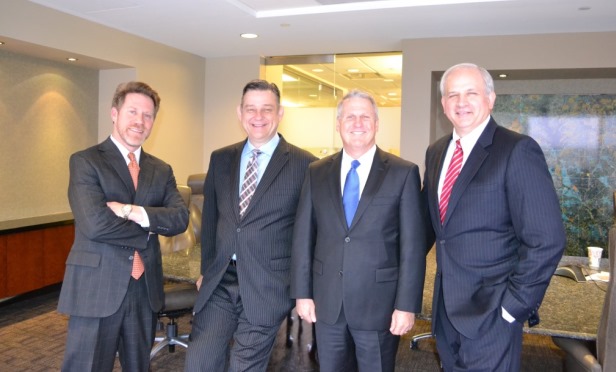
GARLAND, TX—Taking the place of the former Raytheon campus on Jupiter Road, the Jupiter Miller Business Center will begin construction this summer with delivery scheduled for 2018. It was a deal that took months to complete, complicated by various issues including two sellers–one of which is the iconic defense contractor and the other was Lexington.
Younger Partners' Carter Crow, Byron McCoy and Trae Anderson represented one of the sellers, Lexington, in the transaction. JLL's Craig Phelps and Brad Selner represented the other seller, Raytheon.
The buyers, a partnership of Dallas-based developers Langford Property Co.'s Eric Langford and Flaherty Development's Brian Flaherty, plan to build an 800,000-square-foot two-building industrial distribution center covering 40 acres of the 70-acre property.
The deal had many moving parts that required expertise to make the transaction occur, Langford says. “The existing facilities had both office and industrial people working together,” he says. “It was built on an old airport site, so that added to some issues.”
In addition, the property included eight buildings. One building had two separate owners, but shared a common wall and roof so it couldn't be sold by one without the other.
“There's no question this deal had a lot of hair on it,” Langford adds. “But, for an adaptive re-use, taking an office/manufacturing park that has outlived its usefulness and repurposing it into modern industrial is something Brian and I have done, and we felt good about breathing new life into this site.”
Once remediation is done, construction will follow. The developers have hired Bob Moore Construction as the general contractor for the project.
“Dallas has continued to fill with industrial users and the most popular areas like Garland, Great Southwest and Carrollton are all fairly full,” Flaherty says. “There's space in South Dallas, but companies also want to be close to the metroplex's great transportation network, a nearby labor base and access to a DART line. Labor is huge component of a business.”
Langford says land is becoming more valuable than the improvements, even after remediation and demolition.
“We are really out of land in this part of Garland so the best way to get a 1 million-square-foot campus site is to demolish and abate the groundwater contamination and perform asbestos remediation,” Langford tells GlobeSt.com. “There is also scarce land in close-in urban sites of Dallas unless you want to go farther out. This location is in an area known for manufacturing of food, plastics, etc., and good for labor and ease of transportation.”
Langford says more development along the property is likely to follow as the market demands it. North Dallas is becoming barren of large industrial tracts that are desired by developers building manufacturing/distribution facilities, Flaherty adds.
“This location is great because of the good employment base, available hotel rooms, restaurants, daycare facilities and all the things employees need. For the user, there are likely suppliers nearby too,” he says.
The remediation challenges are not new to the development duo of Langford and Flaherty. Clean up and redevelopment is a niche they've comfortably navigated together.
They partnered on a project at 1111 W. Bardin Rd. in Arlington that repurposed the former National Semiconductor property. That project will have 1.25 million square feet across three buildings. It had similar issues to the Raytheon site.
Flaherty also redeveloped the former Forum 303 (later Festival Marketplace) at Texas 360 and Pioneer Parkway in Arlington. He demolished the shopping center and turned it into the Pioneer 360 Business Center filled with warehouse and distribution facilities before flipping it to an institutional buyer.
Both the Arlington and Garland projects will be higher-finish industrial buildings that may be ideal for manufacturers because of the flexible designs, especially compared to nearby facilities are that are 20 years old or older.
“Eric and Brian have the formula down for redevelopment projects like this,” says Crow. “They can overcome obstacles–and even anticipate them–to create fabulous urban infill projects and take obsolete sites and transform them into state-of-the-art redevelopment gems.”

GARLAND, TX—Taking the place of the former Raytheon campus on Jupiter Road, the Jupiter Miller Business Center will begin construction this summer with delivery scheduled for 2018. It was a deal that took months to complete, complicated by various issues including two sellers–one of which is the iconic defense contractor and the other was Lexington.
Younger Partners' Carter Crow, Byron McCoy and Trae Anderson represented one of the sellers, Lexington, in the transaction. JLL's Craig Phelps and Brad Selner represented the other seller, Raytheon.
The buyers, a partnership of Dallas-based developers Langford Property Co.'s Eric Langford and Flaherty Development's Brian Flaherty, plan to build an 800,000-square-foot two-building industrial distribution center covering 40 acres of the 70-acre property.
The deal had many moving parts that required expertise to make the transaction occur, Langford says. “The existing facilities had both office and industrial people working together,” he says. “It was built on an old airport site, so that added to some issues.”
In addition, the property included eight buildings. One building had two separate owners, but shared a common wall and roof so it couldn't be sold by one without the other.
“There's no question this deal had a lot of hair on it,” Langford adds. “But, for an adaptive re-use, taking an office/manufacturing park that has outlived its usefulness and repurposing it into modern industrial is something Brian and I have done, and we felt good about breathing new life into this site.”
Once remediation is done, construction will follow. The developers have hired Bob Moore Construction as the general contractor for the project.
“Dallas has continued to fill with industrial users and the most popular areas like Garland, Great Southwest and Carrollton are all fairly full,” Flaherty says. “There's space in South Dallas, but companies also want to be close to the metroplex's great transportation network, a nearby labor base and access to a DART line. Labor is huge component of a business.”
Langford says land is becoming more valuable than the improvements, even after remediation and demolition.
“We are really out of land in this part of Garland so the best way to get a 1 million-square-foot campus site is to demolish and abate the groundwater contamination and perform asbestos remediation,” Langford tells GlobeSt.com. “There is also scarce land in close-in urban sites of Dallas unless you want to go farther out. This location is in an area known for manufacturing of food, plastics, etc., and good for labor and ease of transportation.”
Langford says more development along the property is likely to follow as the market demands it. North Dallas is becoming barren of large industrial tracts that are desired by developers building manufacturing/distribution facilities, Flaherty adds.
“This location is great because of the good employment base, available hotel rooms, restaurants, daycare facilities and all the things employees need. For the user, there are likely suppliers nearby too,” he says.
The remediation challenges are not new to the development duo of Langford and Flaherty. Clean up and redevelopment is a niche they've comfortably navigated together.
They partnered on a project at 1111 W. Bardin Rd. in Arlington that repurposed the former National Semiconductor property. That project will have 1.25 million square feet across three buildings. It had similar issues to the Raytheon site.
Flaherty also redeveloped the former Forum 303 (later Festival Marketplace) at Texas 360 and Pioneer Parkway in Arlington. He demolished the shopping center and turned it into the Pioneer 360 Business Center filled with warehouse and distribution facilities before flipping it to an institutional buyer.
Both the Arlington and Garland projects will be higher-finish industrial buildings that may be ideal for manufacturers because of the flexible designs, especially compared to nearby facilities are that are 20 years old or older.
“Eric and Brian have the formula down for redevelopment projects like this,” says Crow. “They can overcome obstacles–and even anticipate them–to create fabulous urban infill projects and take obsolete sites and transform them into state-of-the-art redevelopment gems.”
© Touchpoint Markets, All Rights Reserved. Request academic re-use from www.copyright.com. All other uses, submit a request to [email protected]. For more inforrmation visit Asset & Logo Licensing.








